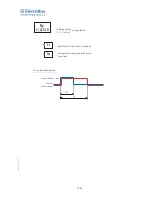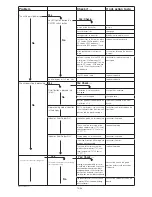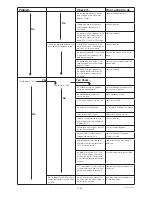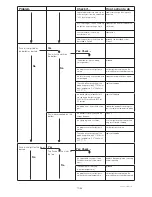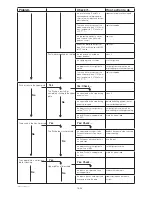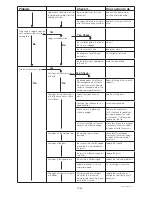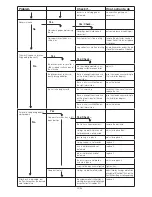
5/38
b) Check the mechanical condition of the appliance
Glass:
- Cracks of the glass.
- State of the silicone sealing around the glass.
- Good position of the insulating parts inside the launching
chamber.
- Check the glass for heavy dirt.
Upper heating plate:
- Smooth movement of the upper heating plate, no noise.
- Easy removal of the upper heating plate.
- Check the presence and tightness of the screws of the cover
of the upper heating plate.
- Check the state of the upper plate cable and the tightness of
the connector to the column of the upper heating plate.
- Cleanliness of the upper cooking chamber.
- Easy plug-in of the upper heating plate with easily locking it
- Cleanliness of the upper heating plate, especially carbon
deposits and damages of the coating.
Upper lid:
- Easy closing and opening of the lid, no noise and no unusual
forces.
- Open the front cover and check the cleanliness of the steam
evacuation chamber.
Remove all particles stuck the grid.
Handle:
- Easy movement of the handle. Limiter screw must be in
place.
- Easy movement of the 2 pins in the handle and its automatic
repositioning.
- Check the tightness of the 2 pin blockers.
- Easy movement of the electromagnet washer.
- Cleanliness of electromagnet washer.
Front of the appliance:
- Cleanliness of the electromagnet.
- Good and tight position of the fl at panel (membrane).
- Check for a big gap between front panel and electro magnet
support.
- Repair or renew the parts, if necessary.
Sides of the appliance
- No blocking of the ventilation holes.
Back of the appliance.
- No blocking of the exhaust holes.
- Check the silicone sealing on the top of the tilting box.
Cable connections (unplugged).
- Check the main power supply cord concerning damages,
burnings etc.
Microwave leakage
Go to this test only if the above described “General integrity and
cleanliness” test was passed!
Prepare and switch on your Microwave Detector (see “List of
required instruments for maintenance & repair” in chapter 2 of
this manual).
Press the two outer program buttons in the same time you plug
in the machine until that you see P1 on the display. (This testing
mode give the possibility to start the microwave cycle without
waiting the end of the preheating mode).
Put the specified load (see
“List of required instruments
for maintenance & repair” in
chapter 2 of this manual)
onto the glass and close the lid.
Start the leakage test immediately (the detector probe must be
at 5cm from the tested part perpendicular to it, verify the position
of your probe inside the detector):
- In front of the appliance horizontally along the gap between
lid and front panel.
- On both sides of the appliance horizontally along the gap
between lid and lateral covers.
- On the back of the appliance horizontally along the gap between
lid and tilting box.
- On the top of the appliance all around the column and the
upper plate cable.
- Inside the steam evacuation chamber (front cover removed!)
Warning
: If the limit of 1.0 mW/cm² or 60V/m in the North
America and 5,0 mW/cm2 or 300V/m in Europe is excee-
ded for more than 3sec at the same position, the appliance
has a microwave leakage and has to be stopped immediately.
(see ” Repair section” in chapter 5 of this manual).
Functioning of the appliance
As the appliance is still in the testing mode and might have not
the right temperature, the appliance has to be switched off and
disconnected from the power supply.
The functioning test has to be executed as follows:
Connection to power supply.
- Verify the version of the User Interface.
Switch on and preheating
- Switch on the appliance.
- Check the temperatures on the glass and on the upper heating
plate.
- Try to push the program buttons (they should not be operational
during preheating).
During operation mode
- Start a cycle with the defi ned load.
- Check correct lid latching.
- Check automatic lid opening.
- Check cooking results (grilling of top and bottom as well as
core temperature in accordance with the chosen program if
using real load.
- Check all other programs.
For all fi ndings please refer to the “troubleshooting” or the “repair
section” in chapter 4 resp. 5 in this manual.
4. HSG troubleshooting
For a fast and effi cient, but also safe elimination of a potential
problem with the appliance, the trained service personnel can
use the following troubleshooting guide.
See the important safety information in Chapter 1 of this service
manual before any intervention on the appliance.
The troubleshooting guide has been set up in such a way that
the real cause behind the problem identifi ed can be found by
going through the troubleshooting guide step by step from the
beginning.
Important!
Appliance installation and any maintenance work must
be carried out only by specialized personnel authori-
zed by the manufacturer. Microwave leakage must be
checked every time you do service to the machine.
HSPP tech GB 03 09
Summary of Contents for HSG Panini
Page 1: ...Service Manual GB 07 2009 HSG Panini Service manual ...
Page 2: ...2 2 50mm 50mm 7 5 190mm ...
Page 3: ......
Page 4: ......
Page 11: ...7 38 Explanation on software settings EU Version U207 ...
Page 12: ...8 38 Explanation on software settings US Version U202 U208 ...
Page 28: ...24 38 HSPP tech GB 03 09 ADJUST THE SPRINGS ...
Page 29: ...25 38 HSPP tech GB 03 09 ...
Page 30: ...26 38 ...
Page 31: ...27 38 5 9 CHANGE THE GAS SPRING ...
Page 32: ...28 38 ...
Page 33: ...29 38 ...
Page 41: ...37 38 ...
Page 43: ......
Page 49: ...Vue éclatée Couvercle Cover exploded view Explosionszeichnung Haube F HSPP FR 03 09 ...
Page 51: ...Esploso coperchio Despiece tapa Sprängskiss lock H HSPP FR 03 09 ...
Page 53: ...Vue éclatée Articulation Hinge exploded view Explosionszeichnung Gelenk J HSPP FR 06 09 ...
Page 55: ...Esploso articolazione Despiece articulación Sprängskiss Rotation L HSPP FR 06 09 ...
Page 59: ...Vue éclatée Electrique Electric exploded view Explosionszeichnung Elektrik P HSPP FR 03 09 ...
Page 61: ...Esploso elettronica Despiece electricidad Sprängskiss elektronik R HSPP FR 03 09 ...
Page 64: ......

















